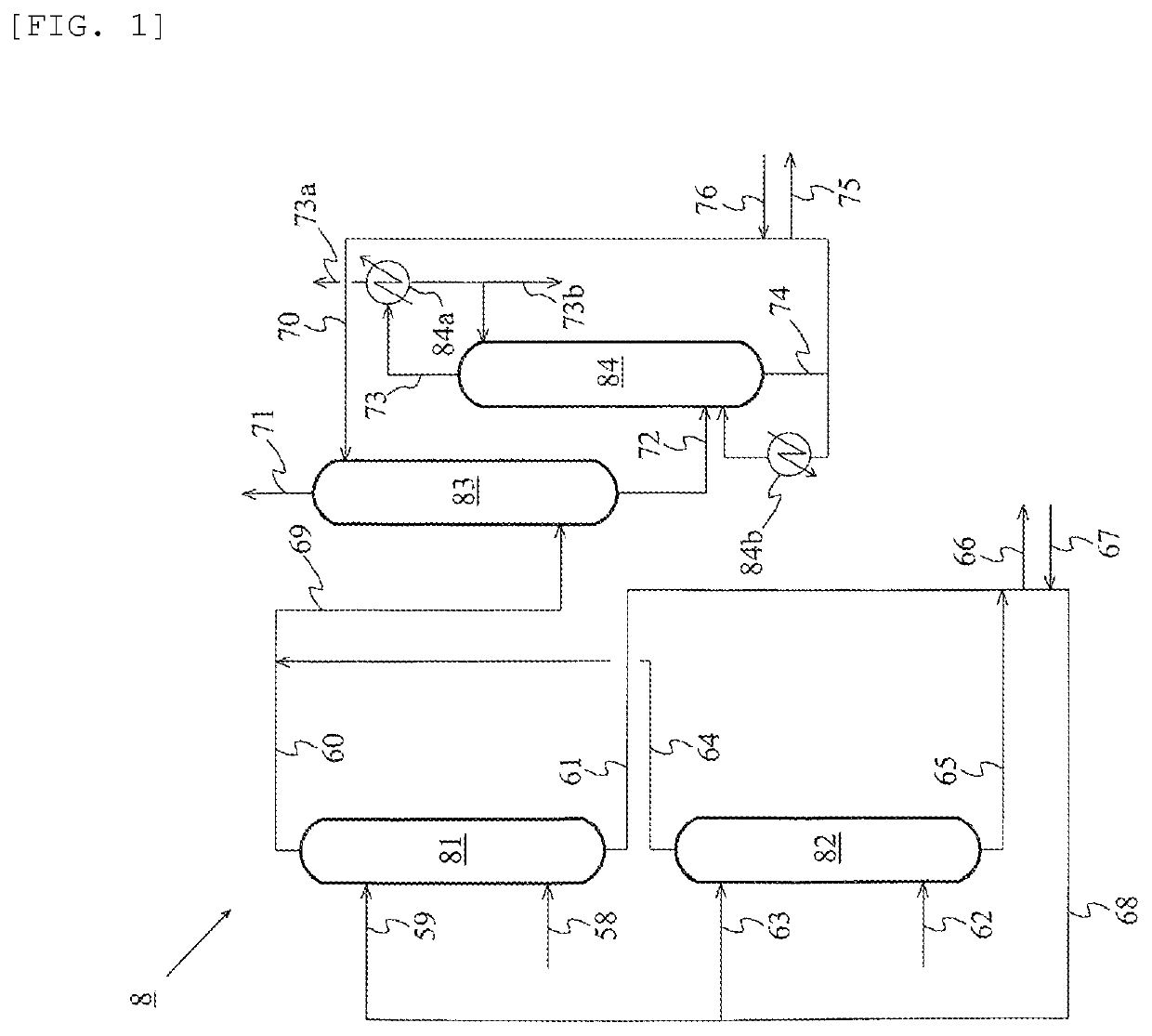Method for producing acetic acid
a technology of acetic acid and acetic acid, which is applied in the preparation of carboxylic compounds, separation/purification of halogenated hydrocarbons, and separation processes, etc. it can solve the problems of corroding the interior of equipment and facilities of hydrogen iodide, environmental problems, etc., and achieves sufficient absorption of hydrogen iodide, efficient separation of methyl iodide, and large difference in boiling point
- Summary
- Abstract
- Description
- Claims
- Application Information
AI Technical Summary
Benefits of technology
Problems solved by technology
Method used
Image
Examples
example 1
[0214]An experiment was performed using the scrubbing system illustrated in FIG. 9(b). A high-pressure charge gas (1) and a low-pressure charge gas (5) were charged respectively to a high-pressure absorption column A (having 5 theoretical plates) and to a low-pressure absorption column B (having 5 theoretical plates); whereas circulating water was introduced through the column tops of the two absorption columns, dispersed, using dispersing plates, from the upper portions of the absorption columns to allow the water to absorb a condensable gas including an iodine compound. Thus, a first absorption step was performed. Absorbing liquids (4) and (8) were drawn from the column bottom of the absorption columns. The absorbing liquids (4) and (8) drawn from the column bottoms of the two absorption columns were merged with each other; a portion (9) of the merged absorbing liquid was drawn, cooled, and combined with fresh water (10) to give an absorbing liquid (11). The absorbing liquid (11) ...
example 2
[0217]An experiment was performed by a procedure similar to that in Example 1, except for not performing the absorption step using the high-pressure absorption column A. The amount of steam used at the distillation column in the stripping step was 90. The flow rates and the concentrations of individual components in the elements (5) to (9) and (11) to (17) are given in Table 4. The results of the corrosivity test are given in Table 5.
[0218]
TABLE 4(6)(5)Low-(8)Low-pressure(7)Low-(9)pres-absorptionLow-pressurePart of First(11)surecolumnpres-absorptionMergedabsorptionCirculatingchargeabsorbingsurecolumnbottoms (4)mergedfirstgasliquidoffgasbottomsand (8))bottomsabsorbentFlow ratepart by mass16.0143.416.0143.4143.41.0143.4H2mass %0.5—0.5————COmass %42.2—42.3————CO2mass %4.7—4.7————CH4mass %5.3—5.3————N2mass %5.7—5.7————ADmass %0.1—0.1————MeImass %37.30.637.30.60.60.60.6MAmass %1.90.31.90.30.30.30.3H2Omass %0.197.70.197.797.897.897.7ACmass %0.00.20.00.20.10.10.2PAmass %———————HImass %0.00...
PUM
| Property | Measurement | Unit |
|---|---|---|
| temperature | aaaaa | aaaaa |
| temperature | aaaaa | aaaaa |
| boiling point | aaaaa | aaaaa |
Abstract
Description
Claims
Application Information
 Login to View More
Login to View More - R&D
- Intellectual Property
- Life Sciences
- Materials
- Tech Scout
- Unparalleled Data Quality
- Higher Quality Content
- 60% Fewer Hallucinations
Browse by: Latest US Patents, China's latest patents, Technical Efficacy Thesaurus, Application Domain, Technology Topic, Popular Technical Reports.
© 2025 PatSnap. All rights reserved.Legal|Privacy policy|Modern Slavery Act Transparency Statement|Sitemap|About US| Contact US: help@patsnap.com



